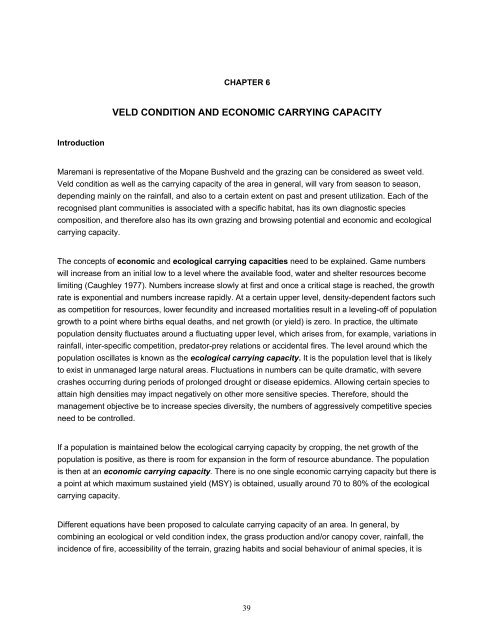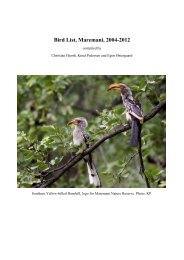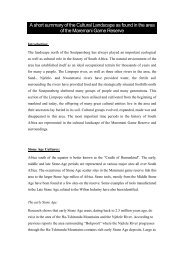the vegetation types and veld condition - Maremani Nature Reserve
the vegetation types and veld condition - Maremani Nature Reserve
the vegetation types and veld condition - Maremani Nature Reserve
Create successful ePaper yourself
Turn your PDF publications into a flip-book with our unique Google optimized e-Paper software.
Introduction<br />
CHAPTER 6<br />
VELD CONDITION AND ECONOMIC CARRYING CAPACITY<br />
<strong>Maremani</strong> is representative of <strong>the</strong> Mopane Bush<strong>veld</strong> <strong>and</strong> <strong>the</strong> grazing can be considered as sweet <strong>veld</strong>.<br />
Veld <strong>condition</strong> as well as <strong>the</strong> carrying capacity of <strong>the</strong> area in general, will vary from season to season,<br />
depending mainly on <strong>the</strong> rainfall, <strong>and</strong> also to a certain extent on past <strong>and</strong> present utilization. Each of <strong>the</strong><br />
recognised plant communities is associated with a specific habitat, has its own diagnostic species<br />
composition, <strong>and</strong> <strong>the</strong>refore also has its own grazing <strong>and</strong> browsing potential <strong>and</strong> economic <strong>and</strong> ecological<br />
carrying capacity.<br />
The concepts of economic <strong>and</strong> ecological carrying capacities need to be explained. Game numbers<br />
will increase from an initial low to a level where <strong>the</strong> available food, water <strong>and</strong> shelter resources become<br />
limiting (Caughley 1977). Numbers increase slowly at first <strong>and</strong> once a critical stage is reached, <strong>the</strong> growth<br />
rate is exponential <strong>and</strong> numbers increase rapidly. At a certain upper level, density-dependent factors such<br />
as competition for resources, lower fecundity <strong>and</strong> increased mortalities result in a leveling-off of population<br />
growth to a point where births equal deaths, <strong>and</strong> net growth (or yield) is zero. In practice, <strong>the</strong> ultimate<br />
population density fluctuates around a fluctuating upper level, which arises from, for example, variations in<br />
rainfall, inter-specific competition, predator-prey relations or accidental fires. The level around which <strong>the</strong><br />
population oscillates is known as <strong>the</strong> ecological carrying capacity. It is <strong>the</strong> population level that is likely<br />
to exist in unmanaged large natural areas. Fluctuations in numbers can be quite dramatic, with severe<br />
crashes occurring during periods of prolonged drought or disease epidemics. Allowing certain species to<br />
attain high densities may impact negatively on o<strong>the</strong>r more sensitive species. Therefore, should <strong>the</strong><br />
management objective be to increase species diversity, <strong>the</strong> numbers of aggressively competitive species<br />
need to be controlled.<br />
If a population is maintained below <strong>the</strong> ecological carrying capacity by cropping, <strong>the</strong> net growth of <strong>the</strong><br />
population is positive, as <strong>the</strong>re is room for expansion in <strong>the</strong> form of resource abundance. The population<br />
is <strong>the</strong>n at an economic carrying capacity. There is no one single economic carrying capacity but <strong>the</strong>re is<br />
a point at which maximum sustained yield (MSY) is obtained, usually around 70 to 80% of <strong>the</strong> ecological<br />
carrying capacity.<br />
Different equations have been proposed to calculate carrying capacity of an area. In general, by<br />
combining an ecological or <strong>veld</strong> <strong>condition</strong> index, <strong>the</strong> grass production <strong>and</strong>/or canopy cover, rainfall, <strong>the</strong><br />
incidence of fire, accessibility of <strong>the</strong> terrain, grazing habits <strong>and</strong> social behaviour of animal species, it is<br />
39




